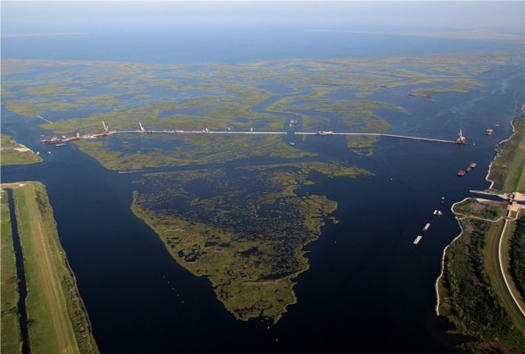
[Storm surge barriers under construction near New Orleans; image source]
In their January issue, Metropolis asks architects and designers to offer predictions, inspirations, and prognostications for the coming decade. It’ll be no great surprise to readers of mammoth that I’m particularly intrigued by the predictions grouped under “landscape architecture”, which involve reconstructed storm barriers in Louisiana, an “embedded infrastructure for carbon storage within the existing physical and social land uses of the city”, and ‘soft coastal engineering’, but there are numerous other fascinating prognostications, including self-healing concrete; bridges which, via “fiber-optic nervous systems”, monitor their own stress levels and temperature differentials to predict failure; mining landfills for “their valuable metals and minerals”; nursebots (“a GPS system with memory in a walker”); the replacement of garbage trucks and garbage cans with garbage shoots and tubes — an “Envac system for waste management”; and “the evolution of the big box into urban spaces” (or, Wal-Mart in a Manhattan basement).


I’ve not heard of self-healing concrete. I did get extremely excited about Calera when doing some research for the Rising Tides competition. Have you heard of it? Best case scenario it could really revolutionize building, capturing wastes and turn them into the best building material in the world- concrete. Of course, there’s not much actual info yet- at least their website is extremely vague. And publish a scientific paper on the subject, though it was purely theoretical and seemed that the results were not yet reproduced and they weren’t sure of scalability. I don’t know; something to keep an eye on.
http://www.calera.com/index.php
I love the idea of concrete being perfected and building being pushed as a major carbon sink- alongside of reforestation and some kind of ocean engineering- upon which we unleash a cadre of young brazilian architects (since everyone knows they are the best with concrete) to redesign the built environment of the Americas. Brazil will be the new seat of the Empire as the Americas coalesce in order to weigh in against China and the Eurozone and their architects will redesign a pan-American infrastructure.
Cool architectural problems/opportunities aside, it just seems intuitive not to rebuild a city below sea level.
faslanyc:
I hadn’t heard of Calera at all — if it does what they say it does, then, yes, exactly. The notion of a pan-American concrete empire run by Brazilian architects (presumably headquartered in a revitalized Brasilia) is just strange enough that it might be plausible….
Mark:
There’s certainly a case to be made for the abandonment of indefensible urban outposts, but it’s also quite possible to do a better job of defending them than Americans have tended to do (the first example of a better defense system almost always being the Dutch, who haven’t really got anywhere to go that isn’t below sea level, and have correspondingly gotten quite good at protecting themselves from the sea). Whatever the cost-benefit analysis says (and it may well mitigate in favor of abandoning imperiled areas, at least in some cases), it’s exceptionally hard to imagine a situation in which Americans (being as hard-nosed and arrogant as we tend to be) would admit that a major city was a geographical mistake (and there are also certainly those who would contend that the problem in Louisiana isn’t the placement of New Orleans, but the way in which the re-engineering of the Mississippi by the Army Corps of Engineers for the benefit of shipping has halted the natural processes of sedimentation which once maintained wetlands and barrier islands as natural storm barriers). Complicated all around.
Indeed – though a reasonable point is that the Dutch generally do not find themselves beset by typhoons.
I agree it would never be abandoned, just saying I think that’s clearly the logical choice from a planning perspective.
Certainly not so frequently, but the Dutch mindset of flood defense is informed by a massive national tragedy, the North Sea flood of 1953, just as ours is being reshaped by Katrina.
If you want to call for the abandonment of Florida, though, you’ll get nothing but encouragement from me…
just as a clarification, I didn’t mean to say “and publish a scientific…”. I meant to say I read a scientific paper, i believe in scientific american. It did have some published results actually, though they weren’t yet verified or anything.
Didn’t mean to imply that you should publish one. A harried end of day comment..